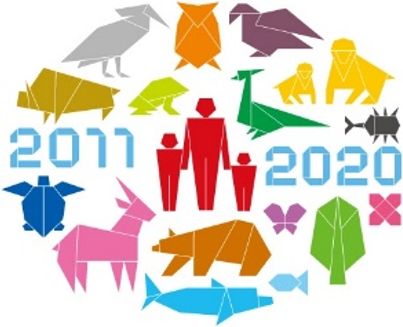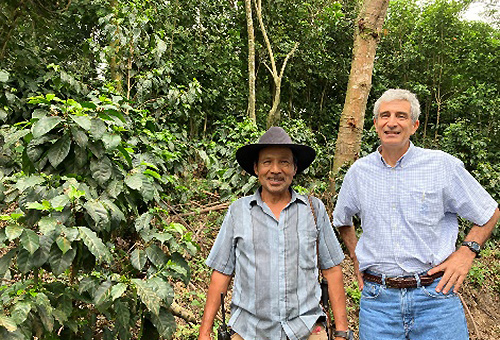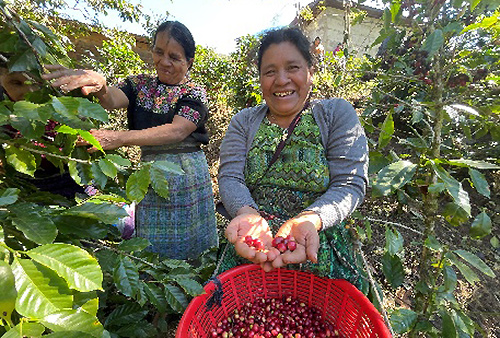View Sumitomo Corporation's Sustainability : Biodiversity
Sumitomo Corporation Group’s business activities largely depend on the wealth of Earth’s diverse living organisms as well as from the biodiversity that is generated by their many networks. Therefore, our Environmental Policy recognizes placing great importance on preserving the environment, including the natural ecosystem and biodiversity as an important issue for us. We make efforts to understand how our business activities that may have a significant impact on biodiversity depend on such biodiversity, as well as what kind of impact such activities have on biodiversity, in order to minimize their impact on ecosystems and contribute to ecosystem restoration.

In June 2022, Sumitomo Corporation endorsed the philosophy of the Taskforce on Nature-related Financial Disclosures (TNFD)* and joined the TNFD Forum supporting TNFD activities. In January 2024, the Board of Directors formally approved our registration as a TNFD Early Adopter of the recommended disclosures announced in September 2023, leading to our first disclosure under that framework in September 2025.
Through disclosures aligned with the TNFD Recommendations and ongoing dialogue with stakeholders, we aim to accelerate efforts to preserve and regenerate natural capital through our business activities.
The Sumitomo Corporation Group conducts risk and opportunity assessments, decision-making, and business execution and oversight under a governance structure of sustainability management. Please refer to Governance of Sustainability Management for the functions of the Board of Directors and the roles of our executives. The key management matters related to sustainability, and sustainability management measures, detailed on this page include natural capital-related topics.
We have established the Corporate Sustainability Committee that provides advice on sustainability measures and other matters to the Management Council, and the Sustainability Advisory Board comprised of outside experts that gives advice on sustainability, including natural capital, to the Corporate Sustainability Committee. Through this structure, advice is reflected in the decision-making of management on issues that are complex and require expertise. In May 2024, natural capital was added to our list of Material Issues. Since then, we have been working to strengthen related initiatives based on advice from our Sustainability Advisory Board.
We define various policies through discussion by the Board of Directors and Management Council, and operate businesses in line with those policies. They include natural capital initiatives such as helping to build a circular economy based on our Environmental Policy, carbon neutrality by 2050 initiatives for our own businesses and society based on our Policies on Climate Change Issues, and risk reduction initiatives such as engagement with diverse stakeholders (indigenous peoples, local communities, etc.) based on the Sumitomo Corporation Group’s Human Rights Policy and international standards*.
Please refer to the following pages for details of each initiative.
Environmental Policy and related initiatives
Policies on Climate Change Issues and related initiatives
Sumitomo Corporation Group’s Human Rights Policy and related initiatives
We updated our Material Issues in May 2024 and added “Preserve and regenerate natural capital” to achieve sustainable growth through resolution of social issues, with consideration also given to the further aggravation of social issues such as climate change and the loss of biodiversity over recent years, the Group’s strengths, and expectations from stakeholders. Additionally, we have set a medium-term goal of “accelerate initiatives toward a nature-positive world by 2030.” To foster understanding of this target and strengthen related initiatives, we have defined our approach to achieving nature-positive as “Minimize the impact of our business on natural capital and continue to transform our business to preserve and regenerate natural capital.” We will accelerate efforts on both fronts, reducing risks and creating opportunities through our business activities.
We are committed to minimizing the impact of our business activities on natural capital.
Our Environmental Policy gives full consideration to preserving the environment, including the natural ecosystem, and maintaining and preserving biodiversity. Following the Environmental Policy, we conduct environmental impact assessments, based on international standards and the laws and regulations of each country, of businesses that are traditionally considered as areas of high nature-related risk, including mining businesses, large-scale development businesses (power generation businesses, etc.) and forestry businesses. We also formulate individual policies if needed and manage suppliers through which implemented measures to mitigate individual impacts on natural capital of those businesses. For example, we have formulated our Forest Management Policy to define sustainable forest management practices in our forestry businesses, and our Sourcing Policy for Forest Products to set out our environmental and social commitments to forest products sourced by all our businesses, and we manage those businesses in line with the policies. (Please refer to our page on Sustainable use of natural Resources and Circular economy for details.)
Additionally, in FY2024, to strengthen our risk-based approach, we began conducting new risk analyses based on natural capital. These analyses identify high-risk businesses and supply chains within the Sumitomo Corporation Group, assessing current and future risks through scenario analysis and deciding on measures to address those risks. For high-risk businesses, we have already identified priority sectors and operations requiring action and conducted risk analyses for five businesses. As a result, we confirmed that measures such as implementing environmental impact assessments, reducing freshwater intake through seawater desalination, and carrying out conservation activities are already in place to lessen impacts on natural capital. For supply chains, we have begun identifying priority supply chains by weighing factors such as whether they handle commodities with a high impact on nature. (Please refer to the “4. Risk & impact management” section below for details.)
We seek to develop new natural capital-related businesses.
In particular, we believe the development of products, services, and schemes that encourage the shift toward a circular economy offer significant business opportunities. Examples of our specific initiatives including the following:
We are also participating in the Ministry of Economy, Trade and Industry’s “Circular Partners (CPs)” program to help develop rules, network, and create businesses that contribute to a circular economy.
Furthermore, to quickly capture emerging trends surrounding natural capital and to promote cross-organizational efforts to preserve and regenerate natural capital through our businesses, we have established the Nature Positive Working Group in FY2023. The working group, led by the Chief Strategy Officer, brings together members from multiple business groups and corporate units. The membership has grown and currently it consists of 50 members. Members share case studies and external trends, strengthening collaboration to accelerate business creation. As an example, we became involved in the carbon credit business through mangrove reforestation in FY2025. The business allows us to contribute to nature positive outcomes by not only promoting market growth toward decarbonization, but also by improving ecosystem services through activities such as using mangroves to provide habitats for diverse species, improving water quality, and contributing to local communities by creating jobs and improving livelihoods for those engaged in mangrove cultivation and management.
We are striving to both reduce risks and create opportunities in the ways listed above. However, we recognize that society as a whole is in the process of developing initiatives toward a nature-positive world, including the expected formulation and updating of international rules and indicators going forward. Therefore, we will work to accurately understand changes in the external environment and update the strategies or respond as necessary, while actively engaging in dialogue with investors and other stakeholders.
The business activities that we conduct as a Group have connections with various social issues. To always reflect those social issues in our management decisions and business execution, we establish company-wide frameworks and policies to appropriately assess, manage, and address the social and environmental impacts of those businesses, and we work to ensure awareness and implementation within the Group. Please refer to Risk Management for details of our approach to social and environmental risks and our related management structure.
In the review process for new investments, the Strategic Business Unit (SBU) in charge of executing the investment conducts social and environmental risk assessment. For example, the assessment contains eight main social and environmental sections focusing on impacts on human rights and local communities, environmental pollution and destruction of nature, and climate change risks. The assessment covers our own business activities in new businesses (companies in which we invest), and those of the supply chain such as their business partners, subcontractors, and direct suppliers, and if problems or issues are identified, we implement any necessary remedy while referring to international standards and criteria. Depending on the size and importance of the new business, the assessment results are used in discussions of the Company Investment Committee, which is an advisory body of the Management Council, and the Management Council, Board of Directors, and other bodies make decisions in light of those discussions.
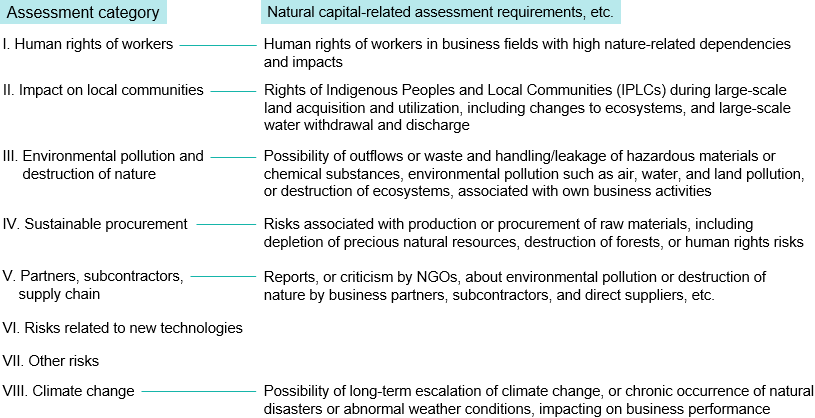
Given the diverse nature of our Group’s existing businesses, the degree of dependence and impact on natural capital varies by business sector and region. While we have traditionally addressed these different features through individual initiatives tailored to each business, we believe that, in order to promote our medium-term goal to “Accelerate initiatives toward a nature-positive world by 2030,” it is also necessary to organize and assess risks and impacts from a company-wide perspective and to consider appropriate measures accordingly.
Since FY2024, we have initiated a risk-based approach that takes a cross-organizational view of the Group’s businesses, including the supply chain, to identify those with high levels of dependence and impact on natural capital, and to manage and address them on a priority basis. The entire supply chain is broadly categorized into our Group companies’ operational sites (direct operations) and other parts of the supply chain. We are identifying priority businesses as well as identifying and assessing nature-related risks and opportunities for each category.
Note:Nature-related risks and opportunities include those related to climate change; however, our company has already conducted and disclosed climate-related risk and opportunity analyses for 22 businesses across six sectors in accordance with the Task Force on Climate-related Financial Disclosures (TCFD). Therefore, under the TNFD framework, our analysis and disclosure of nature-related risks and opportunities focus on factors other than climate change, such as water and ecosystems. For information on climate-related risks and opportunities, please refer to our Climate Change page.
The overall framework for identifying priority businesses within our Group’s direct operations is outlined below.
Overview of the priority business identification process
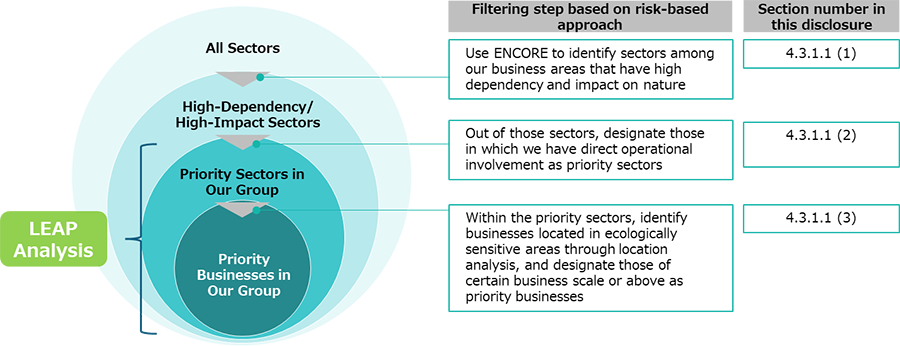
As the first step, we analysed the overall business portfolio to assess the degree of dependence and impact on natural capital, and identified sectors that are generally considered to have high levels of both.
Using the internationally recognized tool ENCORE*, we assessed 33 categories across each sector to evaluate their dependence and impact on natural capital. Based on the results, both dependence and impact levels were categorized into four tiers: “Very High (VH),” “High (H),” “Middle (M),” and “Low (L).” Sectors were classified as high-dependency and high-impact if either the dependence or impact level was rated “Very High (VH),” or if both were rated “High (H),” the second-highest possible rating. As a result, 20 sectors were identified as high-dependency/high-impact sectors.
Selection of high-dependency, high-impact sectors through analysis of general dependency and impact factors related to natural capital
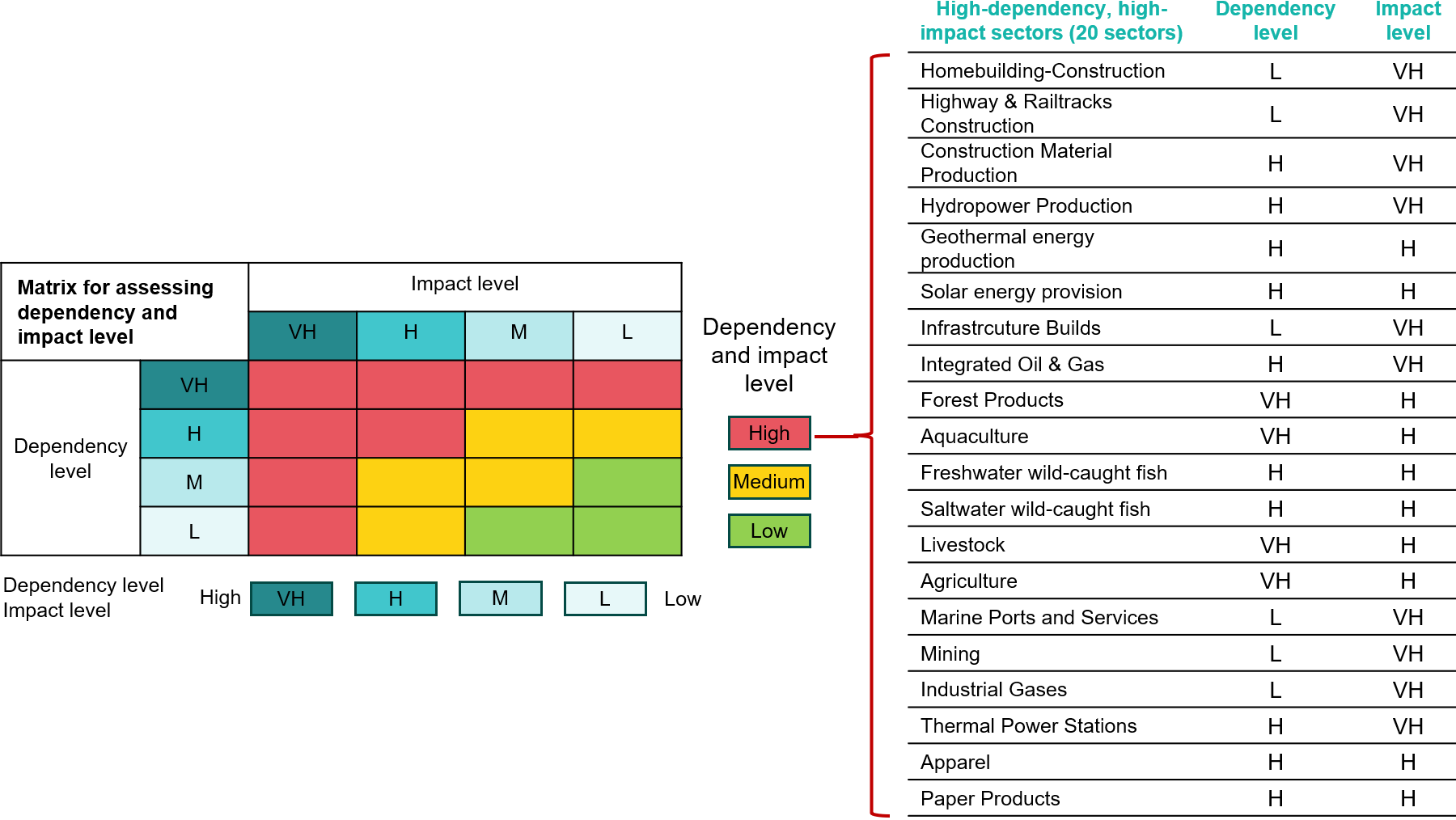
As the next step, we mapped the generally high-dependency and high-impact sectors identified earlier against more than 50 direct operations within our Group and identified 11 priority sectors specific to our Group. The levels of dependence and impact on natural capital for each priority sector are shown below.
List of priority sectors within our Group
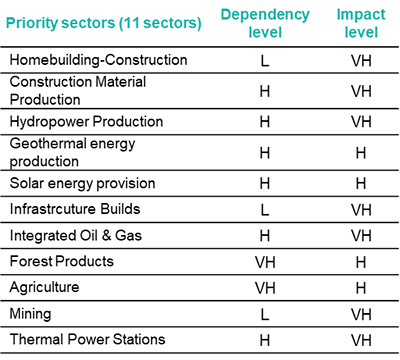
Assessment results for 21 dependency categories by priority sector

Assessment results for 12 impact categories by priority sector

Reference: ENCORE Explore Tool (2018–2023 edition)
Since the impacts, dependencies, risks, and opportunities related to natural capital can vary significantly depending on location, it is essential to take regional characteristics into account. Accordingly, as the next step, we conducted a location-based analysis of over 50 direct operations associated with the identified priority sectors to determine which businesses are situated in ecologically sensitive areas.
Given the limited availability of external tools capable of assessing site-specific risks, our location analysis focused on four key indicators: “Water Stress,” “Ecosystem Sensitivity,” “Tree Cover Loss,” and “Indigenous and Community Lands.”
The methods used to analyse each of these indicators are described below.
Location analysis methodology
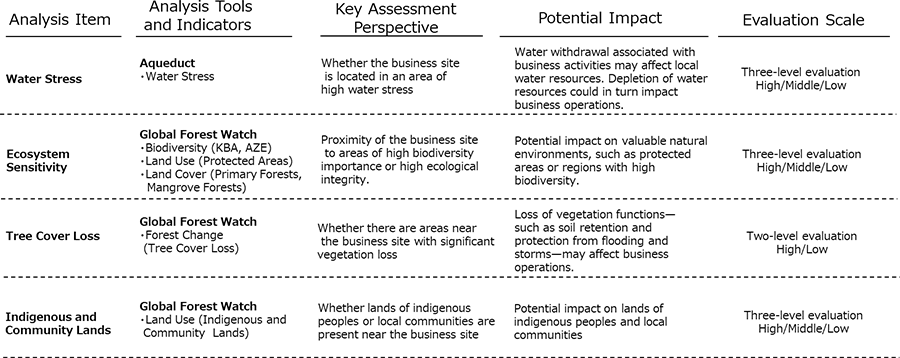
We conducted analysis of Water Stress and Ecosystem Sensitivity for all applicable businesses. For Tree Cover Loss and Indigenous and Community Lands analysis was performed only for businesses where these factors were relevant, taking into account the characteristics of each sector.
Based on the results, among the businesses rated “High” in at least one of the four indicators, we identified priority businesses from the perspective of natural capital at our Group by considering the scale of capital investment and strategic importance.
Among the priority businesses identified through the above steps, we will disclose the LEAP analysis results for the following five businesses in FY2025.
| Sector | Project |
|---|---|
| Agriculture |
|
| Mining |
|
| Thermal Power Generation |
|
None of the five projects subject to location analysis for Indigenous and Community Lands were found to be situated in areas with a high risk of rights infringement related to such lands or territories. Accordingly, further details on this topic have been omitted. Nonetheless, regardless of the results of the risk assessment, our Group remains committed to respecting human rights and upholds international norms concerning the rights of indigenous peoples, such as the United Nations Declaration on the Rights of Indigenous Peoples and the principle of Free, Prior and Informed Consent (FPIC). In regions where indigenous peoples reside, we recognize their unique cultures and histories, comply with applicable laws and environmental permitting requirements of the respective countries or regions, and conduct our operations with due consideration for indigenous peoples and local communities.
Reference: Respect for Human Rights
The analysis was conducted in accordance with the LEAP approach (Locate, Evaluate, Assess, Prepare) recommended by the TNFD, as outlined below.

A summary of the results of analysis conducted for each priority project is as follows.
For all businesses, it was confirmed that appropriate measures have already been implemented to address the items identified as high risk in the location analysis.
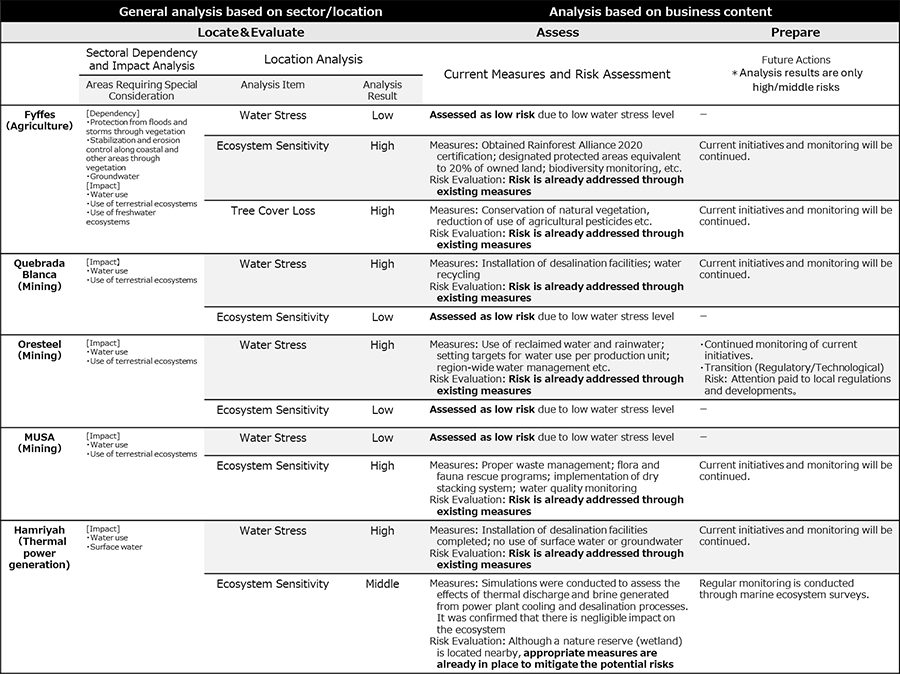
(1) Project Overview
Fyffes, a subsidiary of Sumitomo Corporation (hereinafter “the Business”), engages in a wide range of activities including the production, distribution, and sale of fresh produce. Bananas and pineapples serve as the company’s core product, produced and sourced and procured primarily from Latin America and sold in markets across Europe and North America.
(2) Locate/Evaluate
A location analysis was conducted for farm sites in Latin America, focusing on Water Stress, Ecosystem Sensitivity, and Tree Cover Loss.
The analysis confirmed that none of the sites are subject to high Water Stress. However, in terms of Ecosystem Sensitivity, it was identified that certain sites are located near areas of internationally recognized ecological importance—specifically, Key Biodiversity Areas (KBAs) in Belize and Costa Rica, and a UNESCO Biosphere Reserve in Costa Rica. Additionally, some sites were found to be located in regions experiencing a loss of tree cover.
Note: The results of the analysis on Indigenous and Community Lands have been omitted, as described in Section 4.3.1.1(3).
(3) Assess
Potential Risk Identification and Analysis Results
Based on the sector’s general dependencies and impacts, as well as the results of the location analysis, Ecosystem Sensitivity and Tree Cover Loss were identified as risks requiring particular attention.
Accordingly, scenario analyses were conducted to identify potential future changes in these risks, focusing on both physical and transition risks.
<Physical Risk>
Using the Climate Impact Explorer, a scenario analysis was performed on flood risk, which can significantly affect vegetation cover and ecosystem sensitivity. The results indicated that the risk of flooding is expected to remain low in the future.
<Transition Risk>
The advancement of regulations aimed at preventing deforestation through land-use change—at both national and regional levels—may result in compliance costs, such as those related to enhancing traceability for relevant products. Among the four categories of transition risk—policy and legal, market, technology, and reputation—regulatory risk is considered to be a main risk that needs to be addressed.
Project Assessment and Response Measures for Potential Risks
The Business conducts ongoing materiality analyses on sustainability-related issues and has identified ecosystem conservation, deforestation, and soil erosion as key areas of concern. In line with this recognition, the Business’s banana farm in Costa Rica became the first in the world to obtain the Rainforest Alliance 2020 Certification in 2021. A land conservation program has also been implemented to mitigate soil degradation, covering approximately 20% of all owned land. Specific measures include the designation of conservation areas around banana and pineapple farms, preservation and reforestation of natural vegetation to prevent soil erosion, and biodiversity surveys and conservation planning across farms and approximately 3,000 hectares of conservation zones. Furthermore, various pest and disease management initiatives have been adopted to reduce pesticide use in order to help conserve ecosystems, vegetation cover, and water areas.
As such, the Business is considered to have already implemented effective measures to address potential risks related to ecosystem sensitivity and loss of tree cover.
* For further details on these measures, please refer to the Sustainability Report published by Fyffes.
(4) Prepare
Going forward, the Business will continue its efforts to prevent ecosystem degradation and loss of vegetation cover by maintaining initiatives in designated conservation areas and monitoring the results of biodiversity surveys.
In considering any future farmland development, the Business will also take into account the anticipated increase in regulatory risks and will continue implementing and monitoring measures to prevent deforestation.
| Potential Risk | Indicator | Data | TNFD Indicator Code |
|---|---|---|---|
| Ecosystem Sensitivity | Scope of Terrestrial Ecosystem Conservation | As of 2022, approximately 3,000 hectares of conservation areas have been designated, which accounts for around 20% of the total land owned. | C1.1 |
(1) Project Overview
The Quebrada Blanca Copper Mining Project (hereinafter "the Project") is a copper mining project in the Tarapacá Region of the Republic of Chile, operated jointly with Sumitomo Metal Mining Co., Ltd. (hereinafter "Sumitomo Metal Mining") and major Canadian resource company Teck Resources Limited. Sumitomo Corporation and Sumitomo Metal Mining have participated in the project since 2019. The project entered Phase 2 of its operations in 2023 and plans to carry out continuous, steady long-term production for 25 years or longer.
(2) Locate/Evaluate
Location analyses of Water Stress and Ecosystem Sensitivity were performed for the Project. These analyses confirmed that the level of Water Stress is high at the Project's location. Regarding Ecosystem Sensitivity, there are no areas near the Project site that are considered critical in terms of biodiversity, such as protected habitats, and the risk level was confirmed to be low.
Note: The results of the analysis on Indigenous and Community Lands have been omitted, as described in Section 4.3.1.1(3).
(3) Assess
Potential Risk Identification and Analysis Results
Sector general dependence and impact analysis and location analysis identified Water Stress as a particularly important risk. To assess future changes in latent risk related to Water Stress, we performed scenario analyses of physical and transition risks.
<Physical Risk>
We analyzed future Water Stress forecasts using AQUEDUCT. This analysis showed that for each of the climate change scenarios (Pessimistic, Business as Usual, and Optimistic), Water Stress would remain high in the future ( 2030, 2050, and 2080)
<Transition Risk>
In Chile, the problem of water resource depletion is widely recognized, and there are on going discussions regarding the need to introduce equipment in reducing the amount of freshwater intake, including sea water desalination. Therefore, there is a possibility that restrictions on the use of terrestrial water may become stricter in the future. Because of this, out of the four transition risk categories of policy and legal, market, technology, and reputation, addressing risks in the policy and legal category is considered especially important.
Potential Risk Identification and Analysis Results
The Project has already installed seawater desalination equipment and more than 90% of the water necessary for the Project is being secured through seawater desalination. Furthermore, over 80% of the used water is reused, significantly reducing the amount of freshwater intake. Therefore, the impact of water intake on local water sources has been minimized, and measures have been taken to address the physical risks caused by continuous, high levels of Water Stress and latent risks related to Water Stress, including transition risks in the policy and legal category.
(4) Prepare
| Potential Risk | Indicator | Data (2024)* | TNFD Indicator Code | |||||||||||||||
|---|---|---|---|---|---|---|---|---|---|---|---|---|---|---|---|---|---|---|
| Water Stress | Water withdrawal (ML) |
|
C3.0 | |||||||||||||||
| Water reuse/recycling rate | 84% | A3.2 |
(1) Project Overview
Oresteel Investments (Proprietary) Limited (hereinafter “Oresteel”), an affiliated company of Sumitomo Corporation, is a holding company that invests in Assore, which holds a 50% equity stake in Assmang, a producer of iron ore and manganese ore in South Africa. Based in South Africa, Oresteel indirectly owns multiple mining through its investment in Assore and Assmang (hereafter the “Business”). These include chrome ore mine via Assore, and iron ore and manganese mines via Assmang (a 50:50 joint venture between Assore and African Rainbow Minerals [ARM]).
(2) Locate/Evaluate
For this Business, a location analysis was conducted on Water Stress and Ecosystem Sensitivity. The results confirmed that the areas where the two target mines—Khumani Iron Mine and Black Rock Manganese Mine—are located are subject to high water stress. On the other hand, with regard to ecosystem sensitivity, no protected areas or other biodiversity-sensitive zones were found in the vicinity of the mines.
Note: The results of the analysis on Indigenous and Community Lands have been omitted, as described in Section 4.3.1.1(3).
(3) Assess
Potential Risk Identification and Analysis Results
Based on the sector-level dependency and impact analysis, as well as the results of the location analysis, water stress was identified as a risk requiring particular attention. Accordingly, scenario analyses were conducted to assess how potential risks related to water stress may evolve in the future, focusing on both physical and transition risks.
<Physical Risk>
An analysis using the AQUEDUCT tool was conducted to assess future water stress. The results confirmed that high levels of water stress are expected to persist at the two mine locations under all climate change scenarios— Pessimistic, Business as Usual, and Optimistic—through 2030, 2050, and 2080.
<Transition Risk>
If high levels of water stress continue, potential risks may arise in South Africa such as stricter regulations on freshwater use in the mining sector, and increased costs associated with the implementation of additional facilities or technologies. Among the four categories of transition risk—policy and legal, market, technology, and reputation—regulatory risk and technological risk are considered to be main risks that need to be addressed.
Project Assessment and Response Measures for Potential Risks
At the Khumani Iron Mine, a comprehensive set of measures has been implemented, including water recovery, construction of water storage facilities, and improvements in rainwater management. A target for water usage per ton of production has been set, and performance is being regularly monitored. At the Black Rock Manganese Mine, efforts are underway to reduce total water withdrawal in the region by using reclaimed water, improving rainwater management, and encouraging the use of treated water in nearby communities.
By reducing inland water withdrawals at both mine sites, Oresteel minimizes both the impact on local water sources and the potential operational impact in the event of future water resource depletion. As such, Oresteel is considered to have already implemented effective measures to address potential risks related to water stress.
(4) Prepare
Oresteel operates in compliance with the strict environmental permitting and regulatory requirements of the host country, including those related to water use and ecosystems, and will continue to ensure full compliance with all relevant laws and regulations going forward.
With regard to water stress, identified as a potential risk, we will confirm water use and water reuse/recycling rates through dialogue with operating companies, including the status of efforts at mine sites where targets have not yet been established. We will also continue to closely monitor regulatory developments in the region.
| Potential Risk | Indicator | Data | TNFD Indicator Code | |||||
|---|---|---|---|---|---|---|---|---|
| Water Stress | Water withdrawal (million m3) | Fiscal year* | 2020 | 2021 | 2022 | 2023 | 2024 | C3.0 |
| Khumani | 4.51 | 4.82 | 4.66 | 4.04 | 3.90 | |||
| Black Rock | 1.74 | 1.38 | 1.10 | 2.04 | 1.62 | |||
| *Operational Water withdrawal | ||||||||
| Water use per ton of production (m3/ton) | Khumani | FY2024: 0.312 (Target: 0.319 or less) | ||||||
| Black Rock | *Quantitative targets to be established in the future | |||||||
(1) Project Overview
Mineração Usiminas S/A (hereinafter "the Project") is a joint venture between Usiminas (70% ownership) and Sumitomo Corporation (30%). In the Serra Azul region of Minas Gerais, Brazil, it operates three mines and it produces and sells iron ore.
(2) Locate/Evaluate
Location analyses of Water Stress and Ecosystem Sensitivity were performed for the Project. These analyses found that the level of water stress is not high in the Project's location. However, with respect to ecosystem sensitivity, the project location was confirmed to be in a region with virgin tropical forest with a high level of biodiversity.
Note: The results of the analysis on Indigenous and Community Lands have been omitted, as described in Section 4.3.1.1(3).
(3) Assess
Potential Risk Identification and Analysis Results
Sector general dependence and impact analysis and location analysis identified the use of terrestrial ecosystems as a risk with a particularly large impact. For the Project, which is located near virgin tropical forest with a high level of biodiversity, changes in land use and pollution (especially pollution caused by tailings) are risks for which measures are of particular importance. Therefore, we performed scenario analysis for physical risks and transition risks to assess how these risks could change in the future.
<Physical Risk>
We used Climate Impact Explorer to perform analysis. Our analysis found that Brazil's Minas Gerais, where the Project is located, has been confirmed to have a higher future risk of flooding and extreme rainfall. If tailing dams or other related facilities were to be damaged, pollutants could be released into the surrounding environment, so there is a latent risk of impact on the area's ecosystem and organisms.
<Transition Risk>
In recent years, there has been growing interest in natural capital and the general public is aware of the potential for pollution from tailing facilities in the mining sector. Based on this, there are risks of the tightening of restrictions on the conservation of land when mines are closed down and on the management of tailing dams and risks of rising costs related to additional measures and the introduction of new technologies. Because of this, out of the four transition risk categories of policy and legal, market, reputation, and technology, addressing risks in the policy and legal category and the technology category is considered to be especially important.
Potential Risk Identification and Analysis Results
The Project has performed environmental impact assessments of land use changes and is implementing amelioration measures that minimize the impact of land changes, such as appropriate waste management measures and measures carried out by the plant and wild animal rescue programs. Furthermore, land with an area larger than the mine's footprint has been secured for forest planting activities, conservation easement, and as a conservation and preservation area for the area's original vegetation. Additionally, a wildlife monitoring program is being implemented in the area where the Project is located, and we are considering using the results of studies., in future conservation efforts in the area. Therefore, the Project can deal with latent risks related to changes in land use, including transition risks, through initiatives for mitigating the impact of changes to land characteristics and through conservation and protection activities. We believe these initiatives are also effective in addressing physical risks such as damage to related facilities caused by flooding or localized heavy rains.
With regard to pollution related to tailings, the Project is introducing a highly stable dry stacking system which replaces the traditional tailing dam equipment. This dry stacking system does not release wastewater into the external environment, instead reusing and circulating process water. The Project is managed in compliance with local laws and regulations, including daily visual inspections and geotechnical monitoring as well as monitoring and confirming of water quality.
We therefore believe that these measures can deal with latent risks related to land use and pollution.
(4) Prepare
The Project's operations are performed in compliance with laws and regulations, such as local environmental licensing, concerning water use, ecosystems, and the land of indigenous people, etc. The Project will continue to comply with related laws and regulations. With regard to changes in land use, which have been confirmed to be a latent risk, indicators such as the mining project footprint and the area of conservation and preservation areas, will be monitored.
With regard to pollution, in FY2025, the Project plans to complete our disassembly of the conventional tailing dam, but we will continue to monitor water quality, paying close attention to whether the business activities have an impact on the area's water quality, and the Project will monitor water discharged by the dry stacking system.
| Potential Risk | Indicator | Data (2024) | TNFD Indicator Code |
|---|---|---|---|
| Changes in land use | Area of changes in usage of terrestrial/freshwater/marine ecosystems | Total footprint of mining project: 1,170 km2 | C1.1 |
| Area of protected or restored terrestrial/freshwater/marine ecosystems | Mandated by law or regulation: Environmental Protection Area: 6,700 km2 Legal Reserve: 1,464 km2 |
C1.1 | |
| Pollution from tailings | Wastewater discharge | Discharge of wastewater from the dry stacking system: 0 m3 | C2.1 |
(1) Project Overview
The Hamriyah gas-fired thermal power generation project (hereinafter "the Project") is the first large-scale IPP thermal power generation project in the Emirate of Sharjah, part of the United Arab Emirates. The project is located in Sharjah's Hamriyah area and is made up of three power generation units with a combined output of approx. 1,800 megawatts. The first unit was put into commercial operation in 2021 and the remaining two units were put into commercial operation in 2023.
(2) Locate/Evaluate
Location analyses of Water Stress and Ecosystem Sensitivity were performed for the Project. These analyses confirmed that the level of water stress is high in the Project's location. With regard to ecosystem sensitivity, an area that is a protected habitat was found to exist near the project location.
Note: The results of the analysis on Indigenous and Community Lands have been omitted, as described in Section 4.3.1.1(3).
(3) Assess
Potential Risk Identification and Analysis Results
Sector general dependence and impact analysis and location analysis identified water stress as a risk for which measures were of particular importance. Additionally, with regard to ecosystem sensitivity, the project location is near an area of high importance in terms of biodiversity, so the risk assessment result was "Middle" and there are risks which must be addressed through complementary measures.
To assess how latent risk related to water stress may change in the future, we performed scenario analysis of physical risks and transition risks.
<Physical Risk>
We analyzed future water stress forecasts using AQUEDUCT. As a result of this analysis, we found that for each of the climate change scenarios (Pessimistic, Business as Usual, and Optimistic), water stress would remain extremely high in the future (in 2030, 2050, and 2080).
<Transition Risk>
The issue of water resource depletion is widely discussed in the United Arab Emirates, and national strategies, laws, and regulations recognize the importance of maintaining and managing sustainable water resources. Therefore, we believe there is a latent risk of corresponding rising costs, such as the costs of further water-related measures that companies are required to implement. Because of this, out of the four transition risk categories of policy and legal, market, reputation, and technology, addressing risks in the policy and legal category is considered to be especially important.
Furthermore, with respect to ecosystem sensitivity, we believe there are latent risks requiring complementary measures. Specifically, there is a latent possibility of an environmental impact from pollution in the form of hot wastewater from power plant cooling or highly concentrated saltwater (brine) produced by seawater desalination. There are wetlands near the project site with mangrove trees and precious marine ecosystems, so there could be an impact on these ecosystems.
Potential Risk Identification and Analysis Results
Seawater desalination equipment has already been installed, and the project is securing the water it needs for its business activities by desalinating seawater, without using freshwater. This minimizes the impact of water intake on the area's water resources and the impact of the potential future depletion of water resources on the project. We therefore believe that the Project has already put measures in place to minimize risks related to water stress.
With regard to ecosystem sensitivity, we believe the Project may have an environmental impact in the form of pollution such as hot wastewater and highly concentrated saltwater (brine). However, our environmental impact assessment has confirmed that the wastewater and brine is dispersed and diluted on the sea's surface so their impact on the marine ecosystem is minor and within standards. Additionally, the Project performs annual marine ecosystem studies in nearby areas that are home to coral and pearl oysters. These studies have confirmed that there is no wide-scale environmental damage being caused by the project's activities alone, and we believe that we can deal with the latent risks related to ecosystem sensitivity.
(4) Prepare
| Potential Risk | Indicator | Data | TNFD Indicator Code |
|---|---|---|---|
| Water Stress | Water withdrawal | No freshwater is used (seawater is desalinated for use) [Reference] Seawater consumption 2024: Approx. 840 million m3 |
C3.0 |
| Ecosystem Sensitivity | Temperature of warm wastewater | November 2024: 35.4°C (Outfall-10) 32.3°C (Outfall-30) * The difference in temperature between intake (30.7°C) and discharge is 4.7°C, which is below the threshold set by local standards of ±5°C or less |
C2.1 |
The following provides an overview of the assessment methods used for each of the following perspectives: Water Stress, Ecosystem Sensitivity, Tree Cover Loss, and Indigenous and Community Lands.
Water stress levels (Baseline Water Stress) in the regions where business sites are located were assessed using the AQUEDUCT tool. Based on the assessed level, risk was evaluated in three categories: High Risk, Medium Risk, and Low Risk.
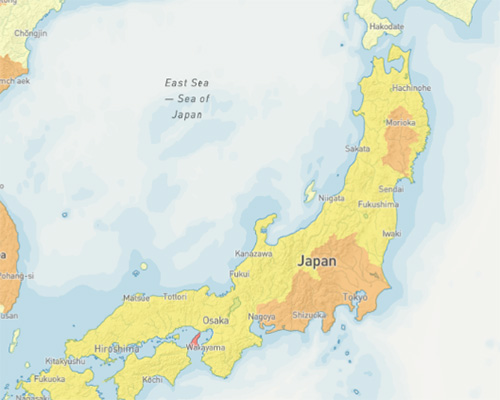
The Global Forest Watch tool was used to assess the proximity of business sites to the following ecologically important areas from a biodiversity perspective. Based on the degree of proximity, risk was evaluated in three categories: High Risk, Medium Risk, and Low Risk.
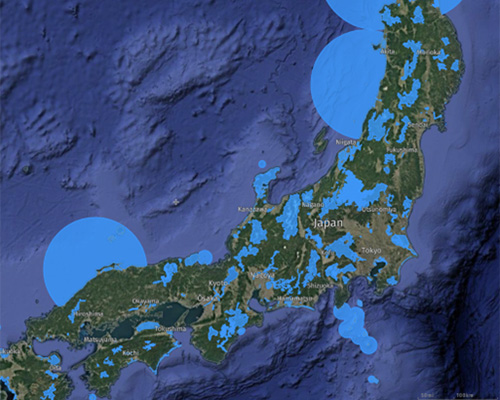
The Global Forest Watch tool was used to assess areas near business sites where there has been significant loss of vegetation cover. Based on the degree of vegetation loss, the risk was evaluated into two categories: High Risk and Low Risk.
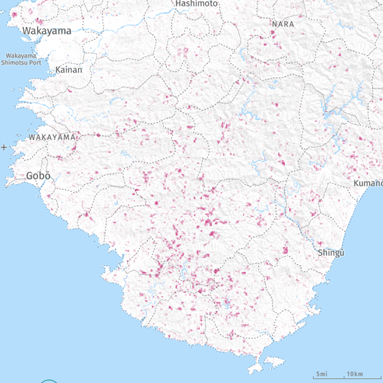
The lives and livelihoods of indigenous peoples and communities may be deeply intertwined with natural capital such as land, resources, and water. In order to identify areas where land with such significant dependencies may be distributed, we used the Global Forest Watch to assess the areas around the business sites. Based on the presence and availability of assessment data, the risk was evaluated into three categories: High Risk, Medium Risk, and Low Risk.

We recognize the need to assess risks not only for our Group’s directly operated businesses, but also for high-dependency/high-impact to nature sectors within our supply chain, and we have begun examining the assessment process. We are working to identify priority supply chains to address first (priority supply chains), based on a risk-based approach that utilizes a variety of information such as details on high-dependency, high-impact sectors, whether we handle the commodities listed on the High Impact Commodity List published by the SBTN*, and the degree of influence we can exert.
As a medium-term target under the Material Issue “preserve and regenerate natural capital,” we have set a goal to “accelerate initiatives toward a nature-positive world by 2030.” Furthermore, to foster understanding of this medium-term target and strengthen related initiatives, we have defined our approach to achieving nature-positive as “minimizing the impact of our business on natural capital and continuing to transform our operations to preserve and regenerate natural capital.” We will continue working toward both reducing risks and creating opportunities through our business activities.
Given the wide range of businesses within the Sumitomo Corporation Group, it is crucial to set metrics and targets for addressing risks and opportunities in each business.
Each SBU voluntarily sets targets related to our Material Issues.
Additionally, for the five priority businesses already analyzed, please refer to 4. Risk and Impact Management for the disclosure of core global metrics and sector-specific metrics.
Our response to the six general requirements in the TNFD guidance for this trial disclosure is detailed below.
The Ambatovy Project in the Republic of Madagascar, which is one of the largest mine development projects in the world, began development in 2007 to expand the supply of nickel, cobalt and other metals. Establishing the environmental target of “no net loss, net gain,” it is conducting a unique biodiversity program.
In the Ambatovy Project, many new facilities, such as mining sites, refinery plants and pipelines, need to be constructed and operated, which poses substantial impacts on the surrounding environment. Particularly in Madagascar, there remains a globally precious natural environment where as many as 1,000 species of endangered animals are living. Giving careful consideration to these natural habitats in developing and operating the project, the biodiversity program accounts for the impact on every site. In developing and implementing plans for the project, special emphasis is placed on environmental management in compliance with not only Madagascar national laws but also various guidelines, such as the World Bank safeguard policy, the International Financial Corporation's (IFC) Performance Standards, the World Health Organization (WHO) standards, and the Equator Principles. In line with the ISO 14001 standard, we are also managing according to the Ambatovy Environmental Management System (EMS).
Under the Ambatovy EMS, we identified a number of priority areas, including flora and fauna habitats and marine ecosystems, and when developing, operating, and closing mines, we formulate management plans for business-related sites, such as plants and port facilities, and work according to those plans. For example, in developing the mining area, we created a buffer zone around the mining site of about 1,600 ha to ensure protection of wild animals. When trees are cut down to develop the mine site, felled trees are left on site for a while so that animals inhabiting these trees can move into the buffer zone. We also conduct ecosystem surveys jointly with international environmental NGOs. If endangered or other species that need to be protected are identified in such a survey, we adopt various programs designed to reduce impacts on ecosystems, for example, relocation of such species to a sanctuary and use of a fish farming system.
Furthermore, as part of this biodiversity program, we are collaborating with governments, local communities, and conservation and development NGOs to apply the IFC and BBOP standards while also promoting a large-scale biodiversity offset program. This is an approach to mitigate impacts of the development on ecosystems by restoring or creating another ecosystem. Specific measures include the conservation of a forest area of about 4,900 ha in the Ankerana area, which has an ecosystem similar to that of the development site of the project. In an attempt to offset the net loss of biodiversity, we have implemented measures to protect four conservation areas of almost 14,000 ha in total, equivalent to about nine times the affected areas, such as protection of areas near the mine site, tree replanting after the installation of pipelines, and tree replanting on the mine site after the closure of the mine. For this biodiversity program and its offsets, we are taking a comprehensive approach that controls not only the impact of businesses, but impacts received prior to them as well.
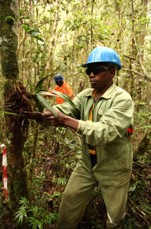
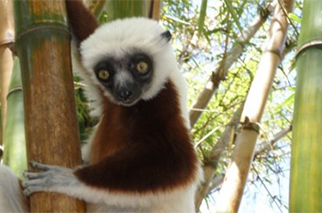
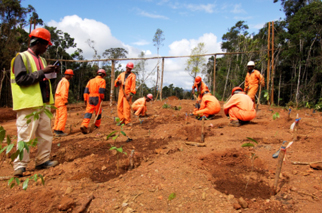
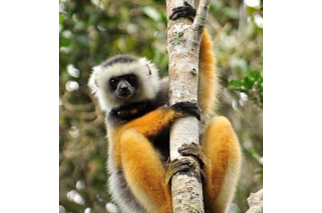
Business and Biodiversity Offsets Program (BBOP) is an initiative to prepare international standards regarding biodiversity offsets, participated in by companies, governments, NGOs and other specialists. The BBOP initiative ended successfully and is now recognized as an international standard for biodiversity offsets that is also referred to by the Convention on Biological Diversity. The Ambatovy Project in Madagascar continues to comply with this standard while maintaining a balance between conserving biodiversity and the lives of local residents.
| 1 | Adherence to the mitigation hierarchy: A biodiversity offset is a commitment to compensate for significant residual adverse impacts on biodiversity identified after appropriate avoidance, minimization and on-site rehabilitation measures have been taken according to the mitigation hierarchy. |
|---|---|
| 2 | Limits to what can be offset: There are situations where residual impacts cannot be fully compensated for by a biodiversity offset because of the irreplaceability or vulnerability of the biodiversity affected. |
| 3 | Landscape Context: A biodiversity offset should be designed and implemented in a landscape context to achieve the expected measurable conservation outcomes taking into account available information on the full range of biological, social and cultural values of biodiversity and supporting an ecosystem approach. |
| 4 | No net loss: A biodiversity offset should be designed and implemented to achieve in situ, measurable conservation outcomes that can reasonably be expected to result in no net loss and preferably a net gain of biodiversity. |
| 5 | Additional conservation outcomes: A biodiversity offset should achieve conservation outcomes above and beyond results that would have occurred if the offset had not taken place. Offset design and implementation should avoid displacing activities harmful to biodiversity to other locations. |
| 6 | Stakeholder participation: In areas affected by the project and by the biodiversity offset, the effective participation of stakeholders should be ensured in decision-making about biodiversity offsets, including their evaluation, selection, design, implementation and monitoring. |
| 7 | Equity: A biodiversity offset should be designed and implemented in an equitable manner, which means the sharing among stakeholders of the rights and responsibilities, risks and rewards associated with a project and offset in a fair and balanced way, respecting legal and customary arrangements. Special consideration should be given to respecting both internationally and nationally recognised rights of indigenous peoples and local communities. |
| 8 | Long-term outcomes: The design and implementation of a biodiversity offset should be based on an adaptive management approach, incorporating monitoring and evaluation, with the objective of securing outcomes that last at least as long as the project’s impacts and preferably in perpetuity. |
| 9 | Transparency: The design and implementation of a biodiversity offset, and communication of its results to the public, should be undertaken in a transparent and timely manner. |
| 10 | Science and traditional knowledge: The design and implementation of a biodiversity offset should be a documented process informed by sound science, including an appropriate consideration of traditional knowledge. |
Dorper Wind Farm generates electricity using wind in a mountainous area of about 130 km2 in Eastern Cape, South Africa. In the Doper wind power generation project, measures to prevent bird strikes are implemented.
Windmills are installed in pastures and bird strikes are caused by birds that flock to feed on the carcasses of livestock and other animals. We therefore ensure to remove animal carcasses found in the power plant.
We also hire local residents to visually confirm if there is any endangered bird species circling around the windmills and, if detected, to send an emergency notice to stop the operation of the windmills. It is our aim to achieve a harmonious balance between wild animal conservation and wind power generation business.
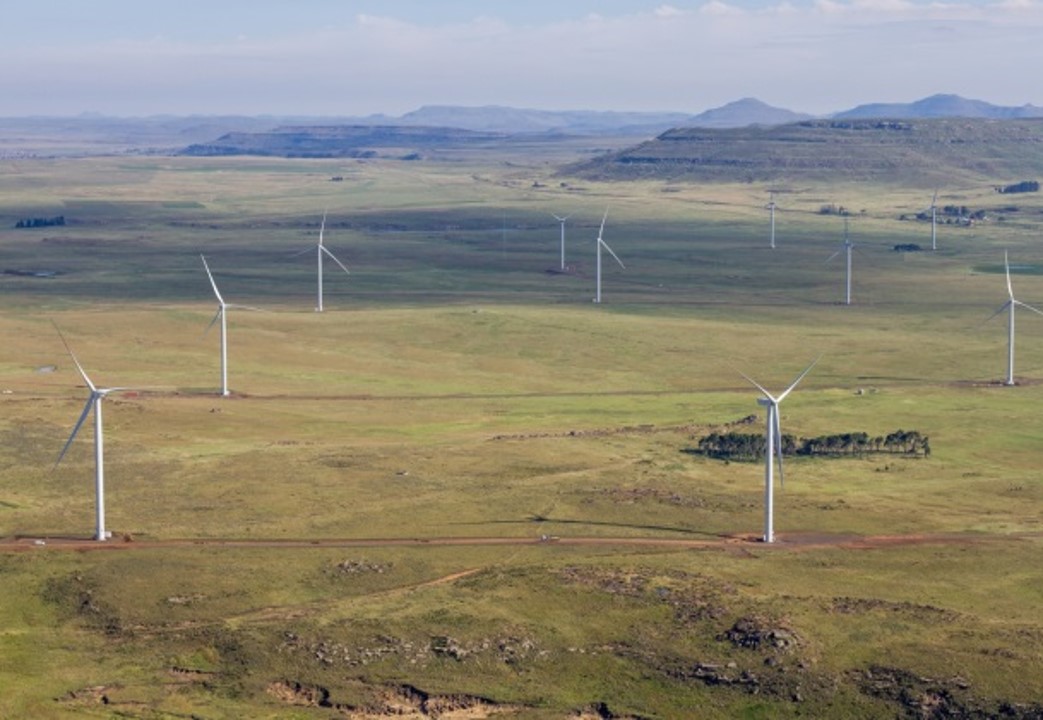
Sumitomo Corporation Group has imported and supplied Bird Friendly®-certified coffee (BF®-certified coffee) since 2004 as part of our biodiversity-friendly activities, which ensures a stable income for farmers. Since FY2014, SC Foods Co., Ltd. started dealing in BF®-certified coffee. BF®-certified coffee is grown under the shade of natural forest trees to conserve the environment and provide migratory birds a place to rest. The BF certification was created by the Smithsonian Migratory Bird Center (SMBC). As of April 2025, 54 farms and agricultural cooperation in 11 countries*1 are certified and part of the proceeds are used for SMBC's research, surveys and conservation activities.

In 2019, this project was recognized by the Japan Committee of the International Union for Conservation of Nature and Natural Resources (IUCN) as a cooperative project authorized by the Japan Committee for the United Nations Decade on Biodiversity (UNDB-J)*2. This authorization means that the project is an important activity to conserve biodiversity as well as an activity that has achieved results toward meeting the Aichi Biodiversity Targets*3. We will continue our efforts to contribute to protecting migratory birds and ecosystems through this project.
